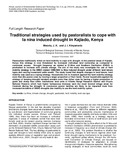Resource information
Pastoralists traditionally relied on herd mobility to cope with drought. In the pastoral areas of Kajiado,
Kenya this strategy is now threatened by increased individual land ownership as compared to
communal access. Drought frequency as related to El-Nino and Southern Oscillation (ENSO) is
predicated to increase with climate change. The aim of the study was investigate the use of herd
mobility strategy in the ENSO related 1999/2000 la Nina induced drought under different land tenure
types and varying household cattle wealth. The study found that despite changes in land tenure, herd
mobility was used as a coping strategy. Households rich in livestock applied the herd mobility strategy
more than the poorer ones by moving a larger proportion of their herds. Poorer households applied the
strategy of keeping drought resistant animals more than richer ones by having a higher proportion of
goats and sheep than cattle. Institutional land units of Kiboko Range Research Station and Chyulu
National Reserve which had higher herbaceous biomass were the most favored refuge areas for
livestock during the drought. In conclusion poorer families are likely to be impacted more from
increased incidents of ENSO droughts due inability to use the herd mobility option.


